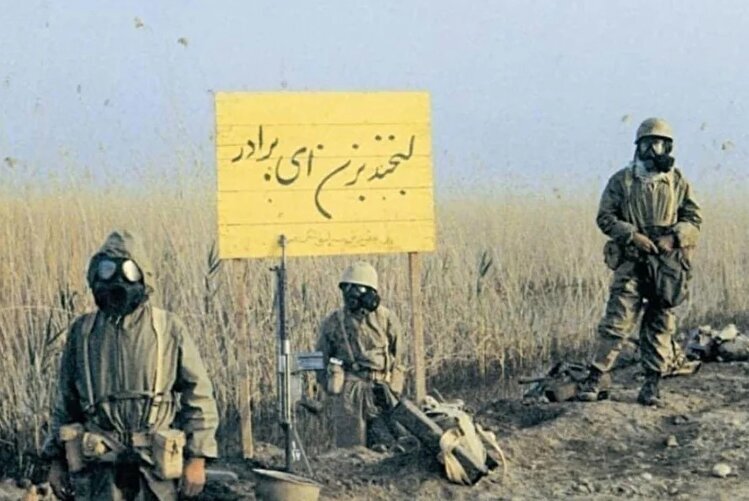Chemical Wounds and Breaths That Are Hard to Take
TEHRAN (Defapress) - In the tumultuous heart of the Middle East, where the winds of a four-season climate blend with agonizing cries, an unforgettable crime was committed, a crime whose wounds remain fresh on the body of our beloved Iran. The Ba'athist regime of Iraq, with hands stained by chemical weapons, struck a blow against this ancient land, a blow that wounded the soul of the nation.

According to a 2014 article published in the Chinese Journal of Traumatology, the chemical attacks that began on January 13, 1981, and continued until the end of the imposed war in January 1988, have been subjected to deep examination. This narrative is not confined to mere statistics; it is a story of suffering and resilience, where every number symbolizes a shattered life.
On January 13, 1981, while the world still slumbered in ignorance, the Iraqi army dropped the first chemical bombs on Halabja in southwestern Iran. This marked the beginning of a dark and bloody path paved by Ba'athist Iraq's use of Nerve Agents (NAs) and Sulfur Mustard (SM). Initially, the attacks were limited, but from August 1983 onwards, as technical issues with the bombs were resolved, the bombardments intensified and continued until January 1988.
For over five years, Iran endured this deadly rain of toxins. In March 1985, Iraq deployed a massive volume of these chemical weapons against Iranian military personnel and civilians, where yellow clouds of mustard gas poisoned the air and stole breath away.
The city of Sardasht, a Kurdish city in northwestern Iran, was targeted with 250-kilogram mustard gas bombs in July 1987 and June 1988. Out of its 12,000 residents, 8,025 were injured and 130 martyred. According to UN experts, this atrocity was a symbol of targeted and premeditated violence.
In February 1988, Oshnaviyeh was subjected to chemical attacks by the Ba'athist regime, leaving 2,680 civilians wounded. This calendar of death swept from the south to the north of Iran, leaving behind more than 20,000 martyrs and 400,000 injured, victims who required long-term care.
The Ba'athist regime's savage brutality was also evident on the battlefields, where nerve gases could martyr combatants in less than 30 seconds. Researchers report that approximately 100,000 Iranians have received treatment due to contamination from these chemical agents, yet it is estimated that around 25,000 civilian chemical casualties remain unidentified.
Sulfur mustard, with an acute fatality rate of 2-3%, is less immediately lethal but causes chronic disabilities. High doses of this chemical (200 mg orally or 3-5 grams dermally) lead to a painful death by causing pulmonary edema, fluid accumulation in the lungs. In contrast, nerve agents like Tabun and Sarin, whose composition was confirmed by the UN as 75% Tabun and 12% Chlorobenzene, cause symptoms such as sweating, nausea, convulsions, and respiratory paralysis by excessively stimulating muscarinic and nicotinic receptors.
These toxins, even found in the blood, skin, and urine samples of the martyrs, caused immediate and agonizing death. Yet these numbers represent only a fraction of the historical calamity. Delayed deaths, like those in Halabja (where 5,000 were martyred and 7,000 injured), reveal the depth of the disaster.
The physical consequences of the wounds inflicted by Iraq upon Iran were extensive and lasting. Sulfur mustard, the most prevalent agent, drives cells to their death by damaging DNA, reducing glutathione, and activating inflammatory factors. Respiratory issues such as chronic bronchitis, pulmonary fibrosis, and life-threatening pulmonary edema were the most common afflictions, affecting 42.5% of 34,000 survivors. Eyes suffered irreversible damage in 39% of cases, including chronic inflammation, dryness, and even blindness. Skin, affected in 24.5% of cases, endured painful injuries ranging from simple redness to severe necrosis, where blisters burned like fire beneath the skin. Immunological changes, through cellular and humoral suppression, made victims susceptible to infections and increased the risk of cancers like stomach and skin cancer. Nerve agents, with direct effects on the central nervous system, caused headaches, insomnia, confusion, and coma. These ailments led to physical deterioration, turning the victims' lives into a perpetual hell.
Yet, this suffering was not limited to physical wounds; the Iranian psyche, that resilient yet wounded spirit, buckled under the weight of these crimes. Psychological disorders were more prevalent among chemical warfare survivors than in the general population: anxiety followed them like a shadow, depression dimmed the light of hope, and post-traumatic stress disorder kept them in a constant state of terror.
Forced migration from contaminated areas, as seen in Sardasht and Halabja, tore families apart and imposed deep emotional burdens on women and children. Research indicates that these attacks caused more than 150 different types of diseases and complications, leading to significant socio-economic consequences as well.
Even 25 years after the war's end, 45,000 Iranians still grapple with the effects of sulfur mustard exposure, and thousands more live with chronic illnesses. With these attacks, the Ba'athist regime of Iraq stole not only lives but also a bright future from the people of Iran. This report, grounded in scientific data, is a cry for wounds that remain unhealed.
